Abstract
Wood–plastic composites (WPCs), abbreviated as WPCs, are typically composite materials made by mixing wood flour and thermoplastic resins, and then shaped through processes such as extrusion or compression. They have emerged as a viable and advanced alternative to traditional wood and plastic materials, offering an amalgamation of the best properties of both. This study utilized discarded milk bottles as the polymer matrix (mainly composed of high-density polyethylene, HDPE) and added wood flour, recycled protective clothing (Tyvek®), and diatomite recycled from brewery waste as reinforcement. Additionally, pre-treated aluminum hydroxide powder from waste artificial marble was added. The results indicated that the optimal processing temperature for the WPCs was 175 °C. The mechanical properties of the material increased with the addition of recycled protective clothing and pre-treated aluminum hydroxide powder. The increase in tensile strength can reach up to 28%. The thermal conductivity of the WPCs also significantly increased with the addition of pre-treated aluminum hydroxide powder. Furthermore, sunlight analysis showed that the surface temperature of the WPCs decreased by approximately 8.5 °C, which corresponds to a reduction of 13% after adding pre-treated aluminum hydroxide powder. Therefore, they can be applied to outdoor cool WPCs to reduce the risk of foot burns or used as roof heat-insulating layers to reduce indoor air conditioning usage, achieving energy-saving and carbon reduction. This study demonstrates that high-performance and high-value green plastics made from various recycled materials can contribute to the goals of a circular economy and sustainable carbon reduction.
1. Introduction
Wood–plastic composites (WPCs) are crucial and promising engineering wood products that have been widely utilized in various fields. WPCs are primarily composed of wood fibers and thermoplastic polymers [,,,], such as polyethylene (PE), polypropylene (PP), polyvinyl chloride (PVC), and polystyrene (PS) [,,,]. The unique combination of advantages derived from both wood and plastic makes WPCs highly suitable for applications in landscaping facilities, transportation, municipal engineering, as well as the interior and exterior decoration and structural elements of buildings [,].
Recently, WPCs have found widespread use in building and construction, furniture manufacturing, automotive components, or other industries. Examples of successful WPC projects include: (1) Building and Construction: The primary application of WPC is in decking, fencing, and siding, where its durability is especially valued for outdoor structures. (2) Outdoor Furniture: WPC’s popularity for outdoor furniture is on the rise due to its weather-resistant properties and minimal maintenance requirements. (3) Automotive Industry: In the automotive sector, WPC is employed for interior panels and trims, providing a lightweight yet durable alternative. (4) Landscaping and Garden: WPC’s resistance to decay makes it suitable for garden beds, planters, and landscape edging. (5) Other Innovative Uses: WPC is being adopted in various industries, including marine applications and consumer goods, demonstrating its versatility and adaptability.
This popularity can be attributed to their water resistance, ease of processing, recyclability, and environmental friendliness [,]. Classified as green composites, WPCs not only originate from sustainable sources of raw materials but are also recyclable, making them a promising choice for reducing production costs and improving resource reuse efficiency through cascade utilization []. Recently, there has been a growing interest in the use of WPCs in the construction field, driven by an increasing awareness of environmental protection and sustainability. This interest is fueled by benefits such as reduced reliance on traditional wood sources, decreased waste generation, and a lower carbon footprint compared to conventional materials, thereby promoting a circular economy.
The shortage of energy and the abnormally hot climate caused by global warming have heightened focus on the development of building materials capable of storing heat and regulating temperature, as well as products like cool WPCs. []. Guo et al. [] developed a series of thermal energy storage composites using paraffin as a phase change material (PCM) and wood flour/high-density polyethylene (WF/HDPE) as the composite matrix. Their results indicated that WF/HDPE composites with paraffin exhibited much slower heating rates than those without paraffin, and composites with higher paraffin content demonstrated better temperature conditioning ability. Xu et al. [] fabricated heat storage WPCs utilizing a biomass porous carbon-based phase change material (PCM) as the latent heat medium and WF/HDPE as the matrix. The PCM, specifically polyethylene glycol (PEG), can absorb and release heat energy through the process of phase change, maintaining the ambient temperature within a comfortable range and achieving the goal of energy conservation and emission reduction. They observed that the materials, both with and without added PCM, reached temperatures of approximately 56 °C and 54 °C, respectively, after heating for about 20 min, resulting in a temperature difference of about 2 °C. Chen et al. [] produced a composite comprising polyethylene glycol 6000 (PEG6000), balsa wood, and boron nitride (BN). The findings indicated that the temperature rise in WOOD/PEG6000/0.3BN was slower than that in WOOD/PEG6000 during the heating process, and WOOD/PEG6000/0.3BN exhibited a lower equilibrium temperature compared to WOOD/PEG6000. This suggests that the high thermal conductivity of BN resulted in a more efficient heat dissipation for the composites. Yang et al. [] sought to assess the reduction effect on the urban heat island (UHI) phenomenon by implementing PCM on building roofs. The study results revealed that the temperature decreased by an average of 6.8 °C when the PCM cool roof system was applied. In addition, Shih et al.’s study [] incorporated thermally conductive nanographite-containing microencapsulated PCM (MEPCM) into HDPE. The thermal conductivity of HDPE increased by 39% to 0.6358 W/m·K, and upon exposure to light, the temperature on the top of the tested composite was approximately 5 °C lower than that of pristine HDPE after the addition of MEPCM. This indicates a significant improvement in temperature regulation. However, the use of PCM may pose leakage issues. If PCM microcapsules or thermal conductive materials (such as boron nitride) are employed, it would significantly increase the cost of WPCs, making them less in line with market demands. Moreover, these materials are not sustainable resources. Therefore, this study aims to develop low-cost WPCs that align with international trends in the circular economy and sustainable environment, without the drawbacks associated with PCM or expensive thermal conductive materials.
The primary material in milk bottles is HDPE, an essential semicrystalline thermoplastic widely used for its attractive combination of easy processability, good chemical resistance, mechanical properties, excellent biocompatibility, recyclability, and low cost []. If discarded milk bottles can be used as the matrix for WPCs, it not only reduces material costs, but also achieves the goal of a circular economy. However, due to the inadequate strength of HDPE and the issue of molecular chain breakage after recycling, the mechanical properties decrease. On the other hand, diatomite is recognized for its safety, non-toxicity, non-combustibility, fire resistance, low density, strong adsorption capacity, light weight, and good mixing ability. Recycled diatomite from the brewery industry has been demonstrated to enhance the mechanical strength and flame resistance of WPCs []. Tyvek® is a registered trademark of the American company DuPont for an exclusive protective material brand. Made from HDPE fibers, it has introduced new dimensions of protection, security, and safety across a wide variety of applications. This product is robust and durable, exhibiting characteristics of toughness and tear resistance. Protective suits made of Tyvek® can effectively shield against various harmful substances such as dust, splashes, aerosols, etc. []. Due to the substantial quantity of recycled diatomite and scraps of protective clothing, applying them to reinforce the mechanical properties of recycled milk bottles not only enhances the strength of WPCs, but also reduces the cost of raw material acquisition.
The main components of the waste from artificial marble are primarily aluminum hydroxide and polymethyl methacrylate. The production factory generates approximately 30 to 60 metric tons of waste powder each month []. Aluminum hydroxide can be converted to aluminum oxide through pre-treatment, and it possesses excellent thermal conductivity, which can enhance the thermal conductivity of WPCs, thereby reducing the surface temperature of WPCs after exposure to sunlight.
Therefore, in this study, discarded milk bottles are used as the matrix, and wood flour, recycled protective clothing, and diatomite from brewery waste are added as reinforcing agents. Additionally, pre-treated waste artificial marble powder is incorporated, with maleic anhydride grafted polyethylene (MAPE) used as a compatibilizer to enhance the interface compatibility between the resin and additives. [,,]. This is a cost-effective approach to obtaining outdoor cool WPCs or roof heat-insulating layers to achieve a cooling effect. This can mitigate damage to the human body from high temperatures, reduce indoor air conditioning usage, and contribute to the objectives of a circular economy and sustainable carbon reduction.
2. Materials and Methods
2.1. Materials
The source of the recycled high-density polyethylene (rHDPE) was discarded milk bottles from the recycling facility in Taiwan (Horng-En Co., Ltd., Changhua City, Taiwan). The trade name is B3022, which has a melt index ranging from 0.15 to 0.21 g/10 min and a density ranging from 0.95 to 0.96 g/cm3. Waste diatomite (DE) was obtained from Taichung Wuri Brewery (Taichung City, Taiwan). Wood flour (WF) was purchased from General Machinery Co., Ltd. (Taichung City, Taiwan). It is produced from softwood, and its average particle size is approximately 180 μm. Recycled protective clothing (Tyvek®) and waste artificial marble powder (Al) were provided by Everlast NFC Co., Ltd. (Taipei City, Taiwan). and Meganite Co. (Taichung City, Taiwan), respectively. Maleic anhydride grafted polyethylene (MAPE) with melting point of 134 °C and density of 0.954 g/cm3 was purchased from Echang Co., Ltd., (Taichung City, Taiwan).
2.2. Pre-Treatment of the Materials
The discarded milk bottles were crushed into pellets smaller than 1 cm on any side. The waste diatomite underwent heat treatment by being placed in a hot air circulation oven (AM-300, E Chung Machinery Co., Taoyuan City, Taiwan) at 200 °C for 3 h. The recycled protective clothing was cut into pieces measuring 1 cm square. The waste artificial marble powder underwent thermal treatment in a high-temperature furnace (DF30, Hong Yu Instrument Co., Ltd., Taichung City, Taiwan) at 300 °C, 400 °C, and 500 °C, each for a duration of 2 h.
2.3. Preparation of WPCs
The rHDPE, MAPE, Tyvek®, DE, Al, and WF were first dried to a constant weight. The rHDPE pellets were then pre-melted at 160 °C or 175 °C in a counter-rotating internal mixer (Brabender PL2000, Duisburg, Germany) with a rotation speed of 40 rpm, followed by the addition of Tyvek®, MAPE, WF, DE, and Al. After being well blended for 300 s, the composite was granulated. For characterization purposes, WPC test samples were prepared by compression molding at 175 °C with a pressure of 1.47 MPa for 5 min, 2.94 MPa for 3 min, and 5.88 MPa for 1 min, in sequence. The formulations of the samples are shown in Table 1, and the preparation schematic of WPCs is displayed as Figure 1.

Table 1.
Formulations of the WPCs.
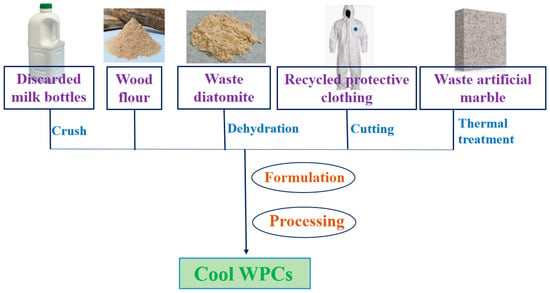
Figure 1.
Preparation schematic of WPCs.
2.4. Characterizations
The thermal decomposition behavior of waste artificial marble powder and WPCs was determined via thermogravimetric analysis (TGA) using TGA Q50, TA Instruments, Inc. (New Castle, DE, USA). All samples, approximately 10 mg each, were scanned from 50 to 600 °C at a heating rate of 10 °C/min under nitrogen flow. X-ray Diffraction (XRD) analysis of samples was conducted at an angular incidence of 0° to 75° using a PANalytical X’Pert PRO (Malvern Panalytical Ltd., Almelo, The Netherlands) with Cu-K radiation (λ = 0.154 nm) at a scanning rate of 10°/min. To study the mechanical performance of the WPCs, all samples were conditioned at 65% relative humidity and 23 °C until equilibrium moisture content was achieved before testing. Five specimens of each sample were used for testing, and the average values were calculated from the obtained results. The tensile tests were carried out following the ASTM D638 test method with a load cell of 20 kN and an extension rate of 50 mm/min using an Instron universal tester (HT-9102, Hung Ta Instrument Co., Ltd., Taichung, Taiwan). A dumbbell-shaped test specimen of 186 mm × 19 mm × 3 mm was then prepared and tested at room temperature. Meanwhile, strip-shaped specimens (127 mm × 12.7 mm × 3.2 mm) were produced for flexural tests following ASTM D790. The three-point flexural tests were conducted using a universal testing machine (HT-9102, Hung Ta Instrument Co., Ltd., Taichung, Taiwan) with a crosshead speed of 3 mm/min. A thermal conductivity detector (TCD, Hot Disk, TPS-500, Gothenburg, Sweden) was employed to measure the thermal conductivity of the WPCs. The samples were compressed into dimensions of 5 cm (L) × 5 cm (W) × 0.5 cm (H) before being placed into the detector. The operating power and time were set at 50 mV and 40 s, respectively. Upon the exposure test, the WPCs were subjected to simulated sunlight using equipment (Figure 2), and the surface temperature of the WPCs was analyzed using an infrared camera (FLIR Cx-Series® Compact Thermal Imaging Camera, Teledyne FLIR, Wilsonville, OR, USA).
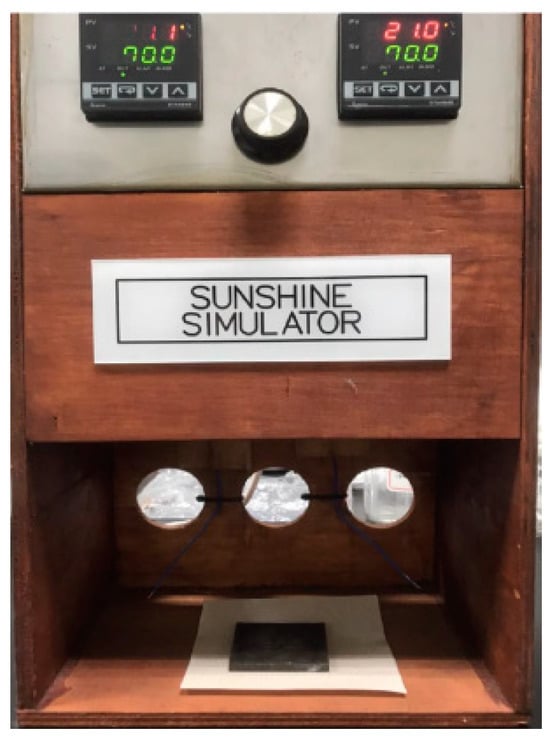
Figure 2.
Simulated sunlight equipment.
3. Result and Discussion
3.1. Analysis of Pre-Treated Waste Artificial Marble Powder
The primary components of artificial marble are polymethyl methacrylate (PMMA) and aluminum hydroxide. Due to the decomposition of PMMA in artificial marble and the requirement that the temperature for converting aluminum hydroxide to alumina must exceed 250 °C, we selected 300 °C, 400 °C, and 500 °C to perform the thermal treatment of artificial marble. Figure 3 illustrates the appearance of waste artificial marble powder after heat treatment at 300 °C, 400 °C, and 500 °C, respectively. It can be observed that as the heat treatment temperature increases, the material color gradually darkens. Figure 4 and Figure 5 depict the thermogravimetric analysis (TGA) and differential thermogravimetric analysis (DTG) of waste artificial marble powder after different temperature treatments. The substance decomposing around 270 °C is identified as PMMA, and at 320 °C aluminum hydroxide begins to decompose. Figure 4 (a) shows a significant weight loss around 270 °C, suggesting a higher PMMA content in the original artificial marble powder compared to the thermally treated samples (Figure 4 (b–d)). Moreover, the results indicate that with an increase in heat treatment temperature, the material’s weight loss decreases, and the char yield increases from 40.07% to 91.77%. This suggests that aluminum hydroxide gradually dehydrates and transforms into aluminum oxide during the heating process. The transformation of aluminum hydroxide into aluminum oxide will enhance the thermal stability, thermal conductivity, and mechanical properties of the powder. Figure 5 (a) illustrates the distinct decomposition peaks of PMMA and aluminum hydroxide in the original artificial marble powder treated at 300 °C. However, a significant reduction in the peak of decomposition around 270 °C after heat treatment (Figure 5 (b–d)), indicating that most of the PMMA has decomposed. The decomposition of PMMA increases the aluminum oxide content in the powder, thereby improving its thermal stability, thermal conductivity, and mechanical properties. Due to the excessively dark color and the lack of significant differences in char yield (91.77%) compared to the 400 °C heat-treated sample (84.57%), the waste artificial marble powder treated at 500 °C is not selected for further study. Considering the reasons mentioned above and energy cost considerations, we have decided to proceed with additional research using the waste artificial marble powder treated at 300 °C and 400 °C.
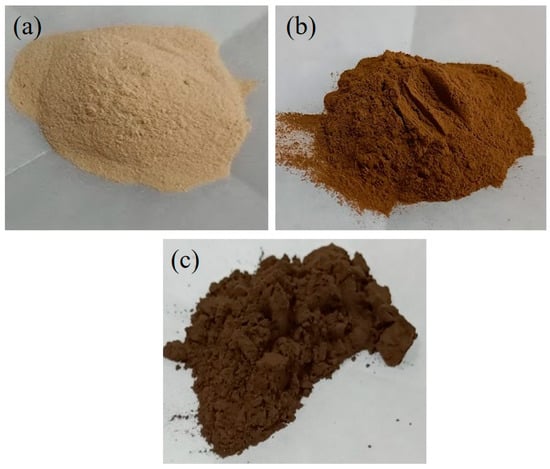
Figure 3.
Appearance of waste artificial marble powder after heat treatment at (a) 300 °C, (b) 400 °C, and (c) 500 °C.
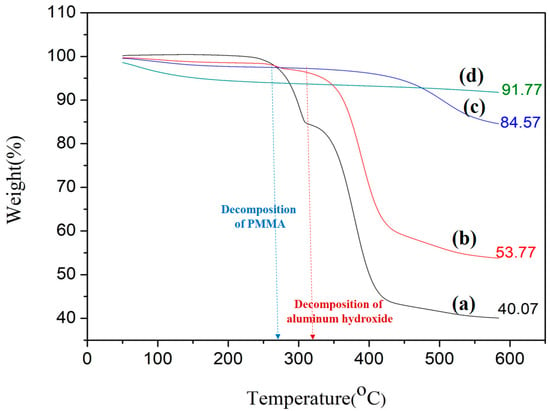
Figure 4.
TGA analysis for (a) original and pre-treated at (b) 300 °C, (c) 400 °C, and (d) 500 °C of waste artificial marble powder.

Figure 5.
DTG analysis for (a) original and pre-treated at (b) 300 °C, (c) 400 °C, and (d) 500 °C of waste artificial marble powder.
The XRD analysis presented in Figure 6 reveals that the characteristic peaks of aluminum hydroxide are located around 13° and 16°, whereas the characteristic peak of aluminum oxide appears around 10°. The pronounced peaks at 13° and 16° in Figure 6 (a) signify the predominance of aluminum hydroxide in the original artificial marble powder. After the heat treatment at 300 °C, the peaks around 13° and 16° significantly diminish, and a new peak around 10° appears in Figure 6 (b). This indicates that, following heat treatment, aluminum hydroxide has progressively dehydrated, converting into aluminum oxide. Furthermore, the peaks around 13° and 16° were almost undetectable, and the peak at 10° increased significantly in Figure 6 (c), indicating that the majority of the aluminum hydroxide had converted to aluminum oxide after being thermally treated at 400 °C.
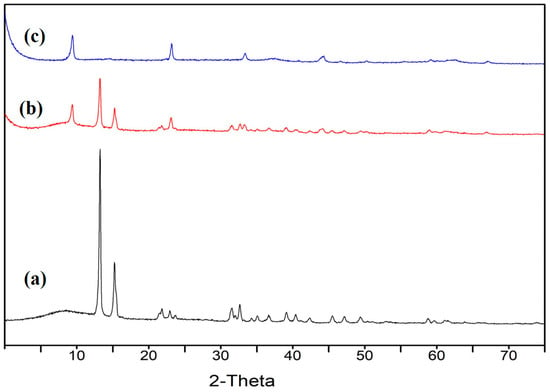
Figure 6.
XRD analysis for (a) original and pre-treated at (b) 300 °C and (c) 400 °C of waste artificial marble powder.
3.2. TGA Analysis of the Composite
Figure 7 and Figure 8 depict the TGA and DTG analysis of the T4-D12 composite. The thermal degradation behavior of the composite is crucial, as it impacts its processing parameters and long-term performance, especially regarding recyclability and environmental impact. Figure 7 illustrates that the decomposition of cellulose begins at approximately 288 °C, resulting in a weight loss of 12.65%. Following this, lignin decomposes at around 358 °C, with a weight loss of 9.96%. Additionally, HDPE from discarded milk bottles decomposes at about 475 °C, leading to a weight loss of 34.69%. The final char yield is approximately 25%. The high char yield will enhance the mechanical properties and durability of the WPCs, particularly in outdoor or high-temperature environments. From Figure 7, it is evident that the proportion of HDPE from discarded milk bottles, at 34.69%, closely aligns with the amount incorporated into our formulation, which is 34%. This suggests that during processing, HDPE from discarded milk bottles and other components mix stably without significant loss. Moreover, the DTG analysis of the T4-D12 composite, as shown in Figure 8, reveals that the composite comprises three main components. Their decomposition temperatures correspond to 288 °C, 358 °C, and 475 °C, respectively.
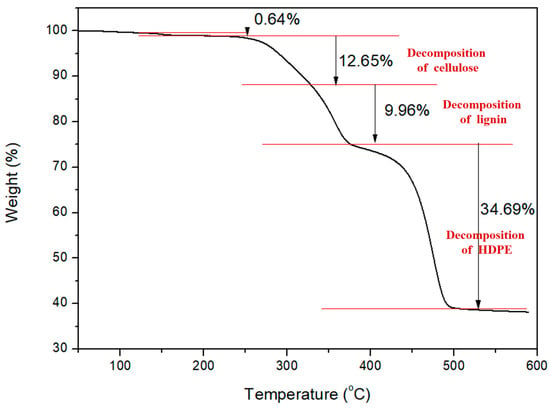
Figure 7.
TGA analysis of T4-D12 composite.
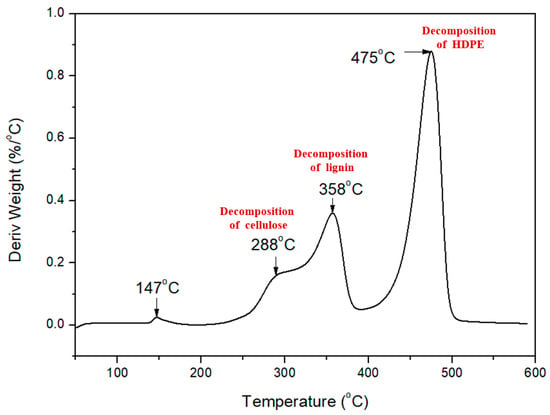
Figure 8.
DTG analysis of T4-D12 composite.
3.3. Mechanical Property Analysis
From the results of the tensile strength analysis presented in Figure 9 and Table 2, it is evident that, for the same formulation (T4-D12), the tensile strength of the material processed at a compounding temperature of 175 °C (14.59 MPa) is significantly higher than that of the material processed at 160 °C (11.11 MPa). Therefore, for subsequent material formulations, the processing temperature is set to 175 °C.
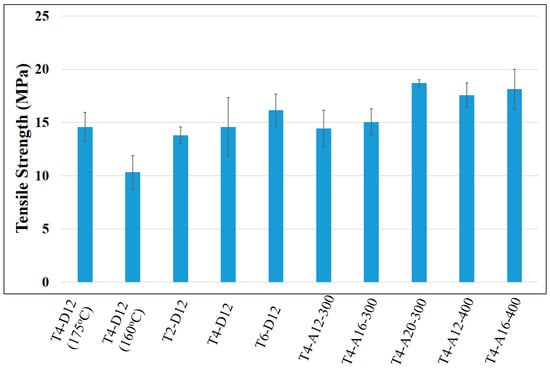
Figure 9.
Tensile strength of the WPCs.

Table 2.
Tensile strength of the WPCs.
By adjusting the content of recycled Tyvek® protective suit in the formulation, we observed that an increased amount of Tyvek® enhances the tensile strength of the material, indicating an increase in material rigidity. However, considering the current insufficient recycling volume of protective suits, we fixed the added amount of recycled Tyvek® at 4% in the subsequent formulations containing waste artificial marble powder. It was found that adding 4% of recycled Tyvek®, without adding diatomite, and gradually replacing part of the wood flour with waste artificial marble powder treated at 300 °C, results in an increase in the tensile strength of the material as the addition amount of the waste artificial marble powder increases. When the addition amount reaches 20% (T4-A20-300), the tensile strength is at its highest (18.71 MPa), indicating that the waste artificial marble powder treated at 300 °C performs better in terms of rigidity than wood flour. Similarly, the addition of waste artificial marble powder treated at 400 °C also exhibited a similar trend in tensile strength performance.
From the analysis of flexural strength shown in Figure 10 and Table 3, it is observed that the flexural strength of T4-D12, processed at a compounding temperature of 175 °C (80.80 MPa), is higher than that of the material processed at 160 °C (70.75 MPa). With an increase in the amount of recycled Tyvek®, there is no significant difference in the material’s flexural strength. Additionally, the WPC incorporating 20% of waste artificial marble powder treated at 300 °C, replacing diatomite and some wood flour (T4-A20-300), exhibits the highest flexural strength (89.76 MPa). This indicates that waste artificial marble powder treated at 300 °C demonstrates superior rigidity compared to wood flour. This result is consistent with the tensile strength analysis. Mazzanti et al. [] prepared wood flour-filled polyethylene using 4 wt% of MAPE as a coupling agent, resulting in a flexural strength of 21.23 ± 0.77 MPa for the produced WPC. In comparison, the flexural strength of the WPCs in this study can reach up to 89.76 ± 5.05 MPa, which is significantly higher than the reference value. This increase is attributed to the reinforcing effect of recycled Tyvek® and thermally treated waste artificial marble powder.
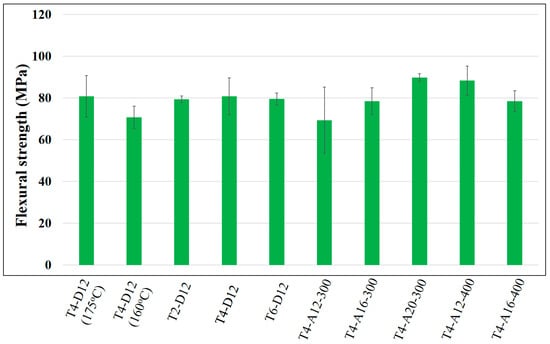
Figure 10.
Flexural strength of the WPCs.

Table 3.
Flexural strength of the WPCs.
However, adding 16% of waste artificial marble powder treated at 400 °C (T4-A16-400) results in a flexural strength (78.48 MPa) that is slightly lower than those of T4-A16-300 and T4-A12-400 (78.51 and 88.34 MPa). Particle size analysis showed that the waste artificial marble powder treated at 300 °C had a particle size of 16.13 ± 0.37 μm, while the powder treated at 400 °C exhibited a particle size of 45.42 ± 27.22 μm. This indicates that the waste artificial marble powder treated at 400 °C has a larger and more uneven particle size. When present in high concentrations, this leads to less uniform dispersion, thereby negatively impacting the material’s flexural strength performance.
3.4. Simulated Sunlight Exposure Analysis
Figure 11 displays the surface temperature analysis of the WPCs after simulated sunlight exposure, conducted using an infrared camera. Figure 12 presents the variations in surface temperature of WPCs with exposure time to simulated sunlight. Furthermore, Table 4 showcases the highest temperatures achieved by the WPCs upon illumination. The results showed that the highest temperatures of WPCs containing artificial marble powder were all lower than that of WPC without the additive (63.9 °C). Moreover, the WPCs containing artificial marble powder pretreated at 400 °C exhibit a higher temperature after exposure to light (63.0 and 59.1 °C) compared to the WPCs containing artificial marble powder pretreated at 300 °C (57.0 and 55.4 °C), indicating a reduced cooling effect. This difference may be attributed to the larger and more uneven particle size of the artificial marble powder pretreated at 400 °C.
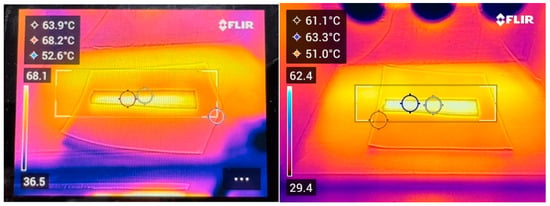
Figure 11.
Surface temperature analysis of the WPCs after simulated sunlight exposure, conducted using an infrared camera.
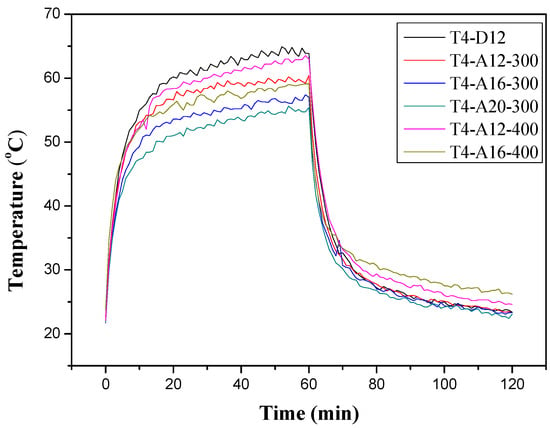
Figure 12.
Variations in surface temperature of WPCs with exposure time to simulated sunlight.

Table 4.
Highest temperatures achieved by the WPCs upon illumination.
It can be observed that the addition of 20% waste artificial marble powder pretreated at 300 °C (T4-A20-300) reduces the post-illumination temperature of the product from 63.9 °C to 55.4 °C. This represents a reduction of approximately 8.5 °C compared to the original material without the additive. This not only addresses concerns related to waste recycling but also enables the production of reusable materials for creating outdoor cool WPCs or roof heat-insulating layers to achieve a cooling effect. The cooling effect of the composites not only contributes to thermal comfort but also reduces air conditioning demand, thereby achieving energy savings and promoting environmental sustainability in building construction and infrastructure projects. Moreover, due to the decrease in surface temperature, it can also further extend the service life and life cycle of WPCs.
3.5. Thermal Conductivity Analysis
The results of the thermal conductivity analysis (Figure 13 and Table 5) reveal that the thermal conductivity of the WPCs increases with the addition of waste artificial marble powder treated at 300 °C. Furthermore, for the WPCs containing waste artificial marble powder pre-treated at 400 °C (T4-A12-400), the thermal conductivity is significantly higher, rising from the non-added value of 0.5543 Wm−1K−1 to 0.6634 Wm−1K−1. This is attributed to the waste artificial marble powder pre-treated at 400 °C, which undergoes a more extensive transformation from aluminum hydroxide to aluminum oxide through dehydration, resulting in a noticeable improvement in thermal conductivity. However, as the content of waste artificial marble powder treated at 400 °C increases (T4-A16-400), the thermal conductivity is affected due to the larger and more uneven particle size of the alumina treated at 400 °C, which causes uneven dispersion. Consequently, the thermal conductivity coefficient decreases (0.5047 Wm−1K−1). Therefore, the heat dissipation effect of the material under illumination is not as effective as that of the WPCs incorporating waste artificial marble powder treated at 300 °C.
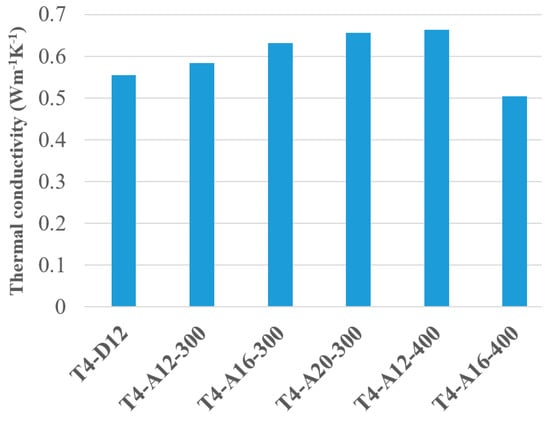
Figure 13.
Thermal conductivity analysis.

Table 5.
The results of thermal conductivity analysis.
4. Conclusions
TGA analysis and X-ray diffraction analysis indicate that waste artificial marble powder, after undergoing heat treatment, undergoes dehydration, transforming aluminum hydroxide into aluminum oxide. Considering color and energy costs, we utilized samples treated at 300 °C and 400 °C. Additionally, the results revealed that at a processing temperature of 175 °C, the WPCs exhibit better tensile and flexural strengths, suggesting that 175 °C is more suitable for material processing compared to the 160 °C condition. Mechanical property analysis demonstrated that with the addition of waste Tyvek®, the tensile strength of the WPCs increased, highlighting the reinforcing effect of Tyvek®. Moreover, it was found that the tensile strength of WPCs can be further enhanced by adding waste artificial marble powder, demonstrating a more effective reinforcement of rigidity compared to wood flour. Significantly, the waste artificial marble powder treated at 300 °C, with its smaller and more uniform particle size, maintains its excellent reinforcing effects even when incorporated in large quantities. Adding waste artificial marble powder to the material notably enhances its thermal conductivity and heat dissipation properties. Specifically, the WPC with 20% waste artificial marble powder treated at 300 °C (T4-A20-300) not only showcases superior tensile and flexural strengths but also, upon exposure to light, achieves a temperature decrease of approximately 8.5 °C compared to the WPC without waste artificial marble powder. This not only addresses waste recycling issues but also allows the production of recyclable outdoor cool WPCs (Figure 14) or roof heat-insulating layers. Furthermore, lowering the surface temperature of the WPCs extends its lifespan and product lifecycle. The environmentally friendly cool wood developed in this study combines the advantages of different recycled materials (milk bottles, protective clothing, and artificial marble). It possesses advantages such as ease of processing, excellent mechanical performance, and rapid thermal conductivity. This innovation can reduce the risk of foot burns and decrease indoor air conditioning usage, achieving energy savings and carbon reduction. It contributes to the goals of a circular economy and sustainable carbon reduction.
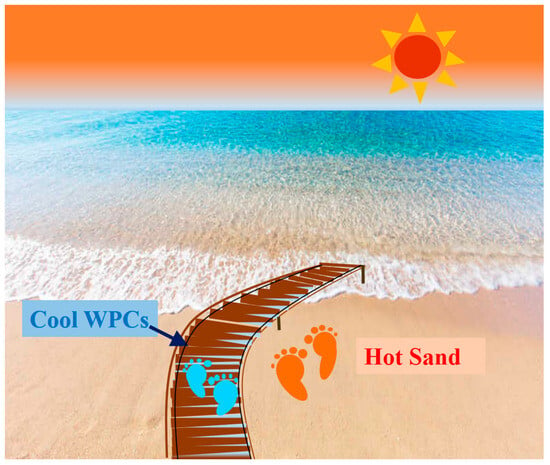
Figure 14.
Schematic of outdoor cool WPCs.
Author Contributions
Conceptualization, Y.-F.S.; methodology and validation, T.-H.H. and W.-Y.D.; data curation, C.-W.C., T.-H.H. and W.-Y.D.; writing—original draft preparation, T.-H.H. and W.-Y.D.; writing—review and editing, Y.-F.S. and C.-W.C.; supervision, Y.-F.S. All authors have read and agreed to the published version of the manuscript.
Funding
This research received no external funding.
Data Availability Statement
Data are contained within the article.
Acknowledgments
The Wurih Brewery of Taiwan Tobacco and Liquor Corporation is appreciated for their generosity in supplying the waste diatomite used in this study. In addition, thanks to Everlast NFC Co., Ltd. and Meganite Co. for providing recycled protective clothing and waste artificial marble powder for this study.
Conflicts of Interest
The authors declare no conflicts of interest.
References
- Deka, B.K.; Maji, T.K. Study on the properties of nanocomposite based on high density polyethylene, polypropylene, polyvinyl chloride and wood. Compos. Part A Appl. Sci. Manuf. 2011, 42, 686–693. [Google Scholar] [CrossRef]
- Väisänen, T.; Das, O.; Tomppo, L. A review on new bio-based constituents for natural fiber-polymer composites. J. Clean. Prod. 2017, 149, 582–596. [Google Scholar] [CrossRef]
- Koivuranta, E.; Hietala, M.; Ämmälä, A.; Oksman, K.; Illikainen, M. Improved durability of lignocellulose-polypropylene composites manufactured using twin-screw extrusion. Compos. Part A Appl. Sci. Manuf. 2017, 101, 265–272. [Google Scholar] [CrossRef]
- Zhang, Q.; Khan, M.U.; Lin, X.; Cai, H.; Lei, H. Temperature varied biochar as a reinforcing filler for high-density polyethylene composites. Compos. Part B Eng. 2019, 175, 107151. [Google Scholar] [CrossRef]
- Pickering, K.L.; Efendy, M.G.A.; Le, T.M. A review of recent developments in natural fibre composites and their mechanical performance. Compos. Part A Appl. Sci. Manuf. 2016, 83, 98–112. [Google Scholar] [CrossRef]
- Xu, B.-R.; Deng, C.; Li, Y.-M.; Lu, P.; Zhao, P.-P.; Wang, Y.-Z. Novel amino glycerin decorated ammonium polyphosphate for the highly-efficient intumescent flame retardance of wood flour/polypropylene composite via simultaneous interfacial and bulk charring. Compos. Part B Eng. 2019, 172, 636–648. [Google Scholar] [CrossRef]
- Arribasplata-Seguin, A.; Quispe-Dominguez, R.; Tupia-Anticona, W.; Acosta-Sullcahuamán, J. Rotational molding parameters of wood-plastic composite materials made of recycled high density polyethylene and wood particles. Compos. Part B Eng. 2021, 217, 108876. [Google Scholar] [CrossRef]
- Ashori, A. Wood-plastic composites as promising green-composites for automotive industries! Bioresour. Technol. 2008, 99, 4661–4667. [Google Scholar] [CrossRef]
- Ou, R.; Zhao, H.; Sui, S.; Song, Y.; Wang, Q. Reinforcing effects of Kevlar fiber on the mechanical properties of wood-flour/high-density-polyethylene composites. Compos. Part A Appl. Sci. Manuf. 2010, 41, 1272–1278. [Google Scholar] [CrossRef]
- Zong, G.; Hao, X.; Hao, J.; Tang, W.; Fang, Y.; Ou, R.; Wang, Q. High-strength, lightweight, co-extruded wood flour-polyvinyl chloride/lumber composites: Effects of wood content in shell layer on mechanical properties, creep resistance, and dimensional stability. J. Clean. Prod. 2020, 244, 118860. [Google Scholar] [CrossRef]
- Taheri, H.; Hietala, M.; Suopajärvi, T.; Liimatainen, H.; Oksman, K. One-Step Twin-Screw Extrusion Process to Fibrillate Deep Eutectic Solvent-Treated Wood to Be Used in Wood Fiber-Polypropylene Composites. ACS Sustain. Chem. Eng. 2021, 9, 883–893. [Google Scholar] [CrossRef]
- Teuber, L.; Osburg, V.-S.; Toporowski, W.; Militz, H.; Krause, A. Wood polymer composites and their contribution to cascading utilisation. J. Clean. Prod. 2016, 110, 9–15. [Google Scholar] [CrossRef]
- Oldcastle APG Co. CoolDeck® Technology. Available online: https://www.moistureshield.com/why-moistureshield/cooldeck-technology/ (accessed on 15 January 2024).
- Guo, X.; Zhang, L.; Cao, J.; Peng, Y. Paraffin/wood flour/high-density polyethylene composites for thermal energy storage material in buildings: A morphology, thermal performance, and mechanical property study. Polym. Compos. 2018, 39, E1643–E1652. [Google Scholar] [CrossRef]
- Xu, J.; Sun, J.; Zhao, J.; Zhang, W.; Zhou, J.; Xu, L.; Guo, H.; Liu, Y.; Zhang, D. Eco-friendly wood plastic composites with biomass-activated carbon-based form-stable phase change material for building energy conversion. Ind. Crops Prod. 2023, 197, 116573. [Google Scholar] [CrossRef]
- Chen, H.; Xuan, J.; Deng, Q.; Gao, Y. WOOD/PCM composite with enhanced energy storage density and anisotropic thermal conductivity. Prog. Nat. Sci. Mater. Int. 2022, 32, 190–195. [Google Scholar] [CrossRef]
- Yang, Y.K.; Kang, I.S.; Chung, M.H.; Kim, S.; Park, J.C. Effect of PCM cool roof system on the reduction in urban heat island phenomenon. Build. Environ. 2017, 122, 411–421. [Google Scholar] [CrossRef]
- Shih, Y.-F.; Chen, P.T.; Lauz, E.M.; Hsu, L.R. Thermally conductive microcapsule/high-density polyethylene composite for energy saving and storage. Mod. Phys. Lett. B 2021, 35, 2150429. [Google Scholar] [CrossRef]
- Savini, G.; Oréfice, R.L. Comparative study of HDPE composites reinforced with microtalc and nanotalcs: High performance filler for improving ductility at low concentration levels. J. Mater. Res. Technol. 2020, 9, 16387–16398. [Google Scholar] [CrossRef]
- Shih, Y.F.; Tsai, W.L. An Environmentally Friendly Recycled-Polyethylene Composite Reinforced by Diatomaceous Earth and Wood Fiber. Key Eng. Mater. 2021, 889, 15–20. [Google Scholar] [CrossRef]
- DUPONT. Tyvek® Forward Together™. Available online: https://www.dupont.com/brands/tyvek.html/ (accessed on 10 January 2024).
- Wang, M. The Role of Aluminum Hydroxide in Artificial Marble. Available online: https://www.linkedin.com/pulse/role-aluminum-hydroxide-artificial-marble-mia-wang (accessed on 17 March 2023).
- Kelleci, O.; Aydemir, D.; Altuntas, E.; Oztel, A.; Kurt, R.; Yorur, H.; Istek, A. Thermoplastic composites of polypropylene/biopolymer blends and wood flour: Parameter optimization with fuzzy-grey relational analysis. Polym. Polym. Compos. 2022, 30, 09673911221100968. [Google Scholar] [CrossRef]
- Hao, X.; Zhou, H.; Xie, Y.; Mu, H.; Wang, Q. Sandwich-structured wood flour/HDPE composite panels: Reinforcement using a linear low-density polyethylene core layer. Constr. Build. Mater. 2018, 164, 489–496. [Google Scholar] [CrossRef]
- Koker, H.S.; Yavuz Ersan, H.; Aytac, A. Effects of PE-g-MA on tensile, thermal, surface, barrier properties, and morphology of plasticized LDPE/chitosan films. Iran. Polym. J. 2023, 32, 263–273. [Google Scholar] [CrossRef]
- Mazzanti, V.; Mollica, F. Bending Properties of Wood Flour Filled Polyethylene in Wet Environment. Procedia Eng. 2017, 200, 68–72. [Google Scholar] [CrossRef]
Disclaimer/Publisher’s Note: The statements, opinions and data contained in all publications are solely those of the individual author(s) and contributor(s) and not of MDPI and/or the editor(s). MDPI and/or the editor(s) disclaim responsibility for any injury to people or property resulting from any ideas, methods, instructions or products referred to in the content. |
© 2024 by the authors. Licensee MDPI, Basel, Switzerland. This article is an open access article distributed under the terms and conditions of the Creative Commons Attribution (CC BY) license (https://creativecommons.org/licenses/by/4.0/).